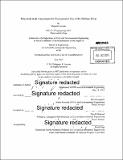| dc.contributor.advisor | David Langseth and Harold Hemond. | en_US |
| dc.contributor.author | Jacques, Margaret (Margaret Rose) | en_US |
| dc.contributor.other | Massachusetts Institute of Technology. Department of Civil and Environmental Engineering. | en_US |
| dc.coverage.spatial | n-us-ma | en_US |
| dc.date.accessioned | 2015-10-30T18:59:25Z | |
| dc.date.available | 2015-10-30T18:59:25Z | |
| dc.date.copyright | 2015 | en_US |
| dc.date.issued | 2015 | en_US |
| dc.identifier.uri | http://hdl.handle.net/1721.1/99600 | |
| dc.description | Thesis: M. Eng., Massachusetts Institute of Technology, Department of Civil and Environmental Engineering, 2015. | en_US |
| dc.description | Cataloged from PDF version of thesis. | en_US |
| dc.description | Includes bibliographical references (pages 47-49). | en_US |
| dc.description.abstract | The Malden River is located in the Greater Boston area of Massachusetts. The River has a long history of abuse and neglect stemming from urbanization and industrial activity along the River and in the surrounding areas. Community groups, however, are advocating restoration of the Malden River to a healthy and thriving ecosystem that also provides a viable outdoor recreational area for the local community. There is concern, however, that bacterial concentrations are at levels that can cause excess gastrointestinal illness to recreational users. As part of assessing this issue, I performed a recreational risk assessment based on microbial concentration data from water quality sampling performed by the Mystic River Watershed Association (MyRWA) and the Massachusetts Water Resources Authority (MWRA). A significant difference in the bacterial data from the two organizations, in which samples are taken approximately one mile from each other, was found. This indicated the possibility of significant bacterial variability in the River and, therefore, risk was calculated separately for each data set. The Wiedenmann (2007) dose response model was used to analyze risk; however, not all site-specific parameters were known. Overall risk, risk after significant rainfall, and seasonal risk were all analyzed. Using the Wiedenmann risk model, I determined that after 0.5 inches of rain in 72 hours, exposure associated with primary and secondary recreation causes the incremental risk to double. The overall and seasonal risk analysis showed that the risks associated with the MyRWA sampling location were consistently at least twice that of the MWRA location. | en_US |
| dc.description.statementofresponsibility | by Margaret Jacques. | en_US |
| dc.format.extent | 92 pages | en_US |
| dc.language.iso | eng | en_US |
| dc.publisher | Massachusetts Institute of Technology | en_US |
| dc.rights | M.I.T. theses are protected by copyright. They may be viewed from this source for any purpose, but reproduction or distribution in any format is prohibited without written permission. See provided URL for inquiries about permission. | en_US |
| dc.rights.uri | http://dspace.mit.edu/handle/1721.1/7582 | en_US |
| dc.subject | Civil and Environmental Engineering. | en_US |
| dc.title | Microbial risk assessment for recreational use of the Malden River | en_US |
| dc.type | Thesis | en_US |
| dc.description.degree | M. Eng. | en_US |
| dc.contributor.department | Massachusetts Institute of Technology. Department of Civil and Environmental Engineering | |
| dc.identifier.oclc | 925483039 | en_US |

